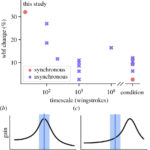Rapid frequency modulation in a resonant system: aerial perturbation recovery in hawkmoths
Centimetre-scale fliers must contend with the high power requirements of flapping flight. Insects have elastic elements in their thoraxes which may reduce the inertial costs of their flapping wings. Matching wingbeat frequency to a mechanical resonance can be energetically favourable, but also poses control challenges. Many insects use frequency modulation on long timescales, but wingstroke-to-wingstroke modulation of wingbeat frequencies in a resonant spring-wing system is potentially costly because muscles must work against the elastic flight system. Nonetheless, rapid frequency and amplitude modulation may be a useful control modality. The hawkmoth Manduca sexta has an elastic thorax capable of storing and returning significant energy. However, its nervous system also has the potential to modulate the driving frequency of flapping because its flight muscles are synchronous. We tested whether hovering hawkmoths rapidly alter frequency during perturbations with vortex rings. We observed both frequency modulation (32% around mean) and amplitude modulation (37%) occurring over several wingstrokes. Instantaneous phase analysis of wing kinematics revealed that more than 85% of perturbation responses required active changes in neurogenic driving frequency. Unlike their robotic counterparts that abdicate frequency modulation for energy efficiency, synchronous insects use wingstroke-to-wingstroke frequency modulation despite the power demands required for deviating from resonance.
Learn about our two Decals!
 Click here to find out more about our Fall Bioinspired Design Decal and our Spring Bioinspired Design in Action Decal – ALL MAJORS are welcome.
Click here to find out more about our Fall Bioinspired Design Decal and our Spring Bioinspired Design in Action Decal – ALL MAJORS are welcome.Berkeley BioDesign Community
 Click here to learn about the BioD: Bio-Inspired Design @ Berkeley student organization or here to signup for more info.
Click here to learn about the BioD: Bio-Inspired Design @ Berkeley student organization or here to signup for more info.Search
Student Login




I imagine that the neurological circuits underlying these processes are governed by both 2d spacing maps with their brains as…
to reduce the impact of car accidents, it may be possible to study the force diverting physics of cockroaches to…
you see this type of head-bobbing stability in many avian creatures related to pigeons like chickens. the head ability to…
not like they taught horses how to run! this is an example of convergent evolution where both sea creatures and…
The brain functions in a similar way with neuronal connections. our brains are able to utilize the multiplicity of connections…